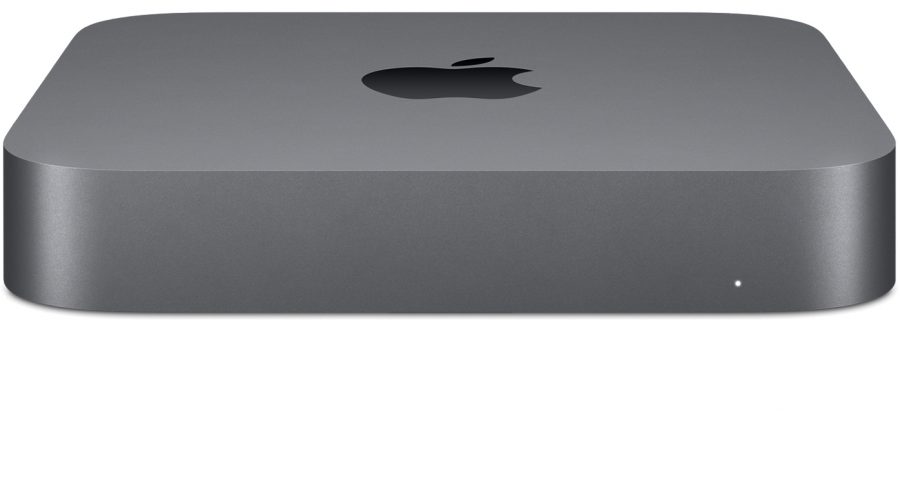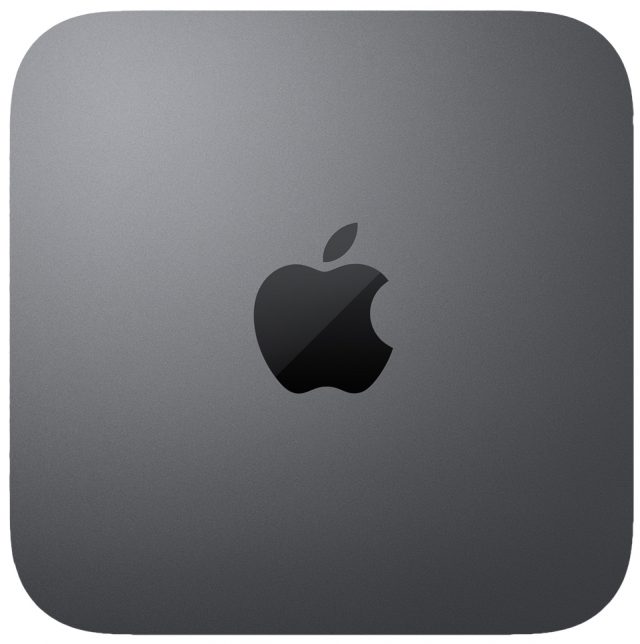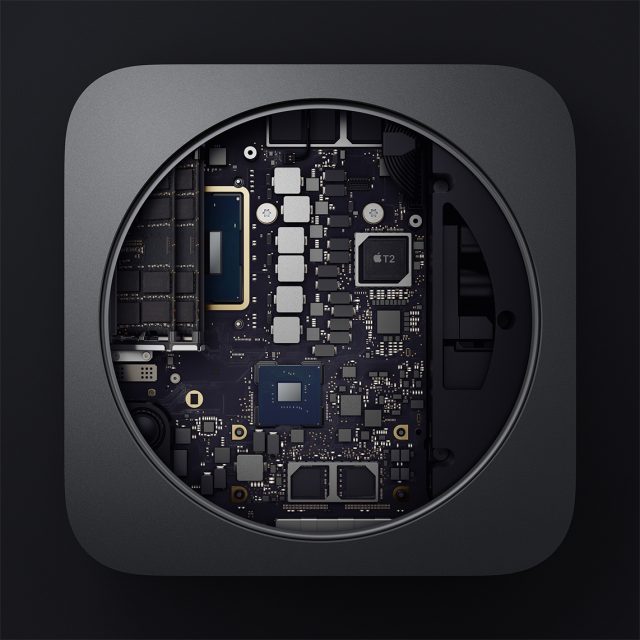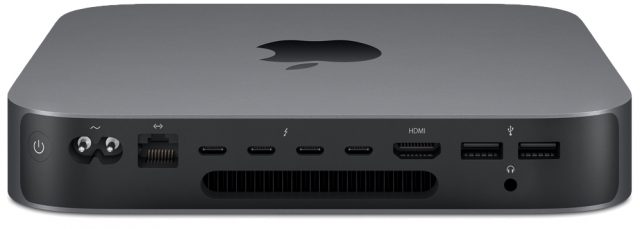
It Lives! Apple Announces Pro-Focused Mac mini
Until today, no current Apple hardware product has been more forgotten or forlorn than the Mac mini. The compact, monitor-less Mac had not seen a significant update in over 4 years, and even that update was seen as lackluster (see “Apple Launches iMac with Retina Display, Refreshes Mac mini,” 16 October 2014). Many thought the Mac mini was dead.
Apple has now put such beliefs to rest, revealing a revamped—though familiar—Mac mini during its special event at the Brooklyn Academy of Music in New York City.
Few Design Changes
In terms of industrial design, the new Mac mini is not a radical revision amid a push in the PC world to create palm-sized, ultraportable computers. It looks much like its predecessor—a large, square, metal slab with rounded corners and the Apple logo on top.
 The new Mac mini is 7.7 inches (19.56 cm) square and 1.4 inches (3.56 cm) tall, exactly like its predecessor, and it weighs 2.9 pounds (1.32 kg), just a shade heavier than its 2.7-pound (1.22 kg) precursor.
The new Mac mini is 7.7 inches (19.56 cm) square and 1.4 inches (3.56 cm) tall, exactly like its predecessor, and it weighs 2.9 pounds (1.32 kg), just a shade heavier than its 2.7-pound (1.22 kg) precursor.
Design departures include a space-gray finish, unlike the lighter gray of yore, and an ecological twist with the Mac mini being manufactured entirely out of recycled aluminum reformulated into an “Apple-designed alloy.”
Improved Performance
As Apple executives pointed out repeatedly during the presentation, the company is aiming this new Mac mini at professionals who use it for live performances, rendering video, running specialized hardware, and more. With the new model, Apple points to a “massive” Mac mini performance increase compared to the previous version, which is welcome but hardly surprising given how puny the old Mac mini was.
 New Mac mini internals include:
New Mac mini internals include:
- Eighth-generation Intel Core processors that start with a 3.6 GHz 4-core i3 version that’s common in low-end Windows-based PCs or a 3.0 GHz 6-core i5. For $200, you can move up to a 3.2 GHz 6-core i7 chip with Turbo Boost of up to 4.6 GHz. Apple claims up to five times the performance compared to the previous Mac mini, and up to 60% speedier graphics performance thanks to the switch to Intel UHD Graphics 630.
- 8 GB of RAM of the 2666 MHz DDR4 SO-DIMM variety in configurations of 16 GB ($200), 32 GB ($600), and 64 GB ($1400). The old model maxed out at 16 GB. Apple says the new memory is up to 7.8 times faster than the older model.
- 128 GB of SSD storage with upgrades to 256 GB ($200), 512 GB ($400), 1 TB ($800), and 2 TB ($1600). Apple is claiming four times the previous read speed, up to 3.4 GB/s sequential read speed.
- The new T2 security chip with a Secure Enclave coprocessor for encrypted storage and secure-boot capabilities.
Unsurprisingly, the new Mac mini will run hotter than its predecessor, and Apple has adjusted to this with a new thermal-dissipation system that circulates air in and out of the computer at twice the previous rate while, the company claims, keeping the computer whisper quiet.
A Full Complement of Ports
The Mac mini has always been notable for its plethora of ports, and the new model is no exception.
The selection this time around includes four Thunderbolt 3 ports and an Ethernet port—with an option for 10-Gigabit Ethernet—along with a standard HDMI 2.0 port, a 3.5 mm headphone jack, and two legacy USB-A ports supporting USB 3.0.
 Annoyingly for a machine that professionals are going to be stuffing in racks, the Mac mini still has no ports on the front. Photographers may be disappointed that there’s no camera-card slot on the front or back.
Annoyingly for a machine that professionals are going to be stuffing in racks, the Mac mini still has no ports on the front. Photographers may be disappointed that there’s no camera-card slot on the front or back.
External Display Options
As a headless Mac, the Mac mini has long served the needs of those who want the flexibility to add a display (along with a keyboard and mouse or trackpad) of their choosing.
In the case of the new Mac mini, options beyond a single display include:
- Two Displays: One display with 5120-by-2880 resolution connected via Thunderbolt 3, plus one display with 4096-by-2160 resolution connected via HDMI 2.0
- Three Displays: Two displays with 4096-by-2304 resolution connected via Thunderbolt 3, plus another display with 4096-by-2160 resolution connected via HDMI 2.0
The Mac mini’s Thunderbolt 3 ports support native DisplayPort output over USB-C. With the right adapters, users of legacy displays can also do Thunderbolt 2, DVI, and VGA output via those ports. DVI is also supported through the HDMI port, with an adapter.
Pricing and Availability
You can order the new Mac mini now, with a 7 November 2018 arrival date. The 4-core i3 configuration with 8 GB of memory and 128 GB of storage starts at $799, and a 6-core i5 version with 8 GB of memory and 256 GB of storage starts at $1099.
Even though it’s more expensive than its predecessor, which opened at $499, the new Mac mini is the only modern Mac whose entry-level configuration falls below the magical $1000 price point. However, build-to-order options will increase the price quickly because Apple charges a steep premium for RAM and storage. A maxed-out Mac mini would run nearly $4200, although dropping to the second tier RAM and SSD options would drop that to $2600. You can buy and install RAM from other vendors to save some money.
If you don’t already have a monitor, keyboard, and mouse, you might also want to take a look at Apple’s entry-level 21.5-inch iMac, which starts at $1099. It has similar specs, including a seventh-generation 2.3 GHz dual-core Intel Core i5 processor, 8 GB of memory, and a 1 TB hard drive, not to mention its integrated 1920-by-1080 display. Just make sure to swap that poky hard drive for a Fusion Drive or SSD.
Nonetheless, the new Mac mini is sure to find an audience among those who already have peripherals on hand, and who want an affordable, compact Mac that can be easily tucked into tight spaces while serving a myriad of uses. It may be a bit pricey for an individual’s home media server, but anyone who needs a tiny Mac for live performances or that can be stacked to make render farm, the Mac mini is once again a serious solution.
“Annoyingly for a machine that professionals are going to be stuffing in racks, the Mac mini still has no ports on the front.”
I always install my Mini’s backwards to have easy access to the ports. I just wish they were not black on black which makes them almost invisible. I keep a flashlight handy.
The prices for more RAM and storage are -outrageous-. I just hope this box is user-upgradeable with 3rd party parts. If not, I’m not buying it. (I’ve owned at least 8 Minis starting with the first model, with 3 currently running here.)
One quibble with the article – many of us want an upgraded Mini so we can continue to use (not add) the display we have chosen.
We should not have to discard a perfectly function display because the OS vendor no longer supports a particular CPU box.
Also, OWC is already selling RAM upgrades.
That’s why we said in relation to the alternative of the 21.5-inch iMac “If you don’t already have a monitor, keyboard, and mouse…” Though at this point, I have to admit that the only displays I have kicking around are old, small, and crufty.
Thanks for the pointer to OWC. Their prices are indeed a lot lower:
I do like modular component systems –
An Apple 21" Aluminum Framed Cinema Display purchased with a Dual-G5 tower is still in use as the CPU box has been upgraded, first to a Macmini3,1, then a Macmini6,2. It now is the secondary screen to a Dell U2412 which joined the Apple screen early in this sequence.
I guess I picked up the habit years ago when I upgraded individual sound system components as budget allowed. Only now it is CPUs and Storage instead of turntables, amplifiers, and speakers.
Unfortunately, a fusion drive is no longer available for the mini. It was a good compromise between SSD speed and regular HDD capacity.
For one use of a Mac mini is our office using existing monitors is important. We must use an approved calibrated monitor with the Kodak InSite proofing system. This means no iMac So we would like to continue using our expensive calibrated monitors that we use with our current Mac minis. Of course this isn’t the scenario of buying a Mac mini so as to save a few dollars on a monitor. Buying an iMac is less expensive than a Mac mini plus an approved monitor.
If Apple didn’t release a new Mac mini we would eventually have to replace our color proofing stations with Windows computers.
PAUL CHERNOFF
Director of Information Technology
Washingtonian Media
It would take a bunch of space, but why couldn’t you plug your calibrated monitor via an adapter into the iMac? So, you would have an elegant 2-monitor system.
I can’t answer for Paul, but in my case, I would not have space for another display, especially one as difficult to VESA mount as most iMacs are.
There is no space. The area the Macs are in, which is a room where we have tight control over the lighting is too small.
I like the Mac mini update. The mini is again an attractive little Mac. Lots of potential applications.
It’s true the price hike is a bit of a bummer. And paying $200 for +8 GB RAM is annoying. But if that is the price to pay to get an up-to-date powerful versatile little Mac, at least I personally will be ok with that. Thanks, Apple, for recommitting to the Mac mini.
We finally gave up waiting for Mac mini upgrades about 18 months ago as the graphics cards in our 2012 (?) models didn’t have the grunt to run Vectorworks so we jumped platforms to PC.
Even now it seems that the video cards in these new minis rely on accessing the main ram rather than dedicated vram. No inspiration there to revert back from the PCs we built.
The price bump really is depressing! I always feel the Mini was a nice affordable unit for someone who didn’t need a ton of power and it was definitely on my list for the inevitable time that my G4 stops working. The ones up to 2012 were user upgradeable. I now have a craigslist search setup to see if I can find one locally.
Back in the day, I always bought the best machine I could afford even if the RAM and hard drive were a little less than I wanted. But within a couple of years I’d be able to upgrade the rest at more reasonable prices. I wish Apple would go back to that model.
Diane
I don’t think the mini was ever meant to be for running professional software like Vectorworks. However, graphics cards sharing the main RAM is much less of a big deal now because the main RAM is much faster and it’s easier to have more RAM. Now that the mini has Thunderbolt 3, an external graphics card can be added but you’d definitely be paying a lot more for the whole package compared to a PC built for the job.
The new mini’s RAM is still user-replaceable, I definitely would pay less and install 3rd party RAM myself. The internal drive is fixed but with Thunderbolt, it’s easy to add more storage without compromising performance, if that’s what’s important. That was true of the 2014 Mac mini as well but I think USB-C storage will have a larger market and will be more affordable.
Other World Computing has a couple left: New & Used Mac mini Desktops from OWC
I bought a more recent used one from them last year; it’s still going strong.
While you are absolutely correct that fast storage can be added for cheap later thanks to TB3, it is indeed a somewhat inelegant solution to then have some external drive (that can be accidentally disconnected) dangling off what would otherwise be a svelte solid unit with lots of horsepower.
Don’t get me wrong, I like the new mini and despite its high price tag I think it makes for a great Mac. But considering we were able to retain SO-DIMMs and access to them for later upgrades, it does feel like a bit of a bummer that the internal SSD had to be soldered rather than placing it on a card that could be swapped ensuring this little Mac remains usable for many years. (not saying I’m surprised, Apple does like soldering)
Apple’s RAM option pricing is a pain, there’s no sugar coating it. Unfortunately, that’s been going on for a long time and like others have pointed out, that isn’t likely to change for the better at all.
That said, it’s great the Mac mini can be ordered from Apple with minimum RAM and then upgraded for much less to a decent amount of RAM in simple DIY manner, no electronics skills required. That’s really nice on the Mac mini. What I also really like is that unlike on the 13" portables, the new Mac mini allows for lots of RAM headroom. 16GB seems too tight to me (heck that’s how my MBP arrived in 2013). So I’d probably go for 32 GB now. Good to know there’s a simple path to 64 GB later on.
A new Mini with the configuration similar to the one I have, 2012 Mini, will cost around $1,500. Apple’s trade-in offer for my old computer is measly $95. I guess the era of an inexpensive and affordable computer is over.
I am looking to replace my late 2009 mini in which I upgraded my RAM to 8 GB and replaced the HDD with a 1 TB SSD. A similar configuration 2018 mini at Apple prices is just over the top! So what to do?
Go for a second hand 2012 quad core I can upgrade myself for far less? But how long will Apple still support that with OS upgrades?
Buy the basic 6 core 2018 mini, upgrade the RAM myself and add a 1 TB external SSD over Thunderbolt? But what will that do for performance?
Personally, I think that’s what I’d be looking at. The internal SSD will likely be large enough for macOS and apps. Then use a fast external SSD for media. I would think performance should be just fine, considering the TB3 connection should have more than enough bandwidth to support the roughly 500 MB/s of a SATA III SSD or even the ~3 GB/s of an M.2 SSD.
I have a mid 2010 27" iMac which I am assured by EtreCheck is now considered “vintage”. The display is still working perfectly. In fact, the whole computer still works fine with the exception of the CD/DVD internal drive. And I use an external Blu Ray/DVD drive which solved that problem.
So, is it logical and possible to buy a new Mac mini and route the display information over to the iMac? I certainly am not running very high powered software. Email, Safari, Epson scanner and printer, Cadintosh and Graphic Converter. They all run just fine today but I’m expecting that the next Mac OS release will not load onto the iMac.
If I were able to have the Mac mini do the heavy duty computing and the vintage iMac for the 27" display and perhaps to run the older 32 bit applications that might be an inexpensive upgrade path.
According to the latest listing https://support.apple.com/HT201624, your iMac is “Obsolete” world-wide (meaning at least some repair parts are no longer available), so EtreCheck is not yet up-to-speed on this. I suppose it is possible that the new Apple Repair Vintage Apple Products Pilot could be extended further, but that might be a stretch.
-Al-
It is possible for some Macs to be used in Targeted Display Mode. Note that they still have to be able to boot, then switch to display mode.
Yours seems to be one of the 3 models of iMac that can do it.
iMac (27-inch, Late 2009)
iMac (27-inch, Mid 2010)
iMac (Mid 2011-Mid 2014)
Later and earlier models can not be used in Targeted Display mode.
More details here: https://support.apple.com/en-ca/HT204592
Cheers,
Dave
David R. and Al V.
Thanks for the info. I will think seriously about keeping the iMac for its display and getting a Mac mini with some stuff to make it run a little faster than this does. An SSD seems like a very good idea. I don’t want to have to chase down replacements for all the 32 bit apps right away.
Thanks again. I’ve bookmarked the pages you pointed me to.
Macs tend to have good resale value. You could try to sell off your old iMac and use that money to buy a good screen to go with your mini. This 27" doesn’t come with retina density, but at $400 it’s an inexpensive yet very good IPS panel with LED backlight and narrow bezels. It’s matte too.
The “retina” version is $534.
I did that, sold my 2011 iMac I had been using as a monitor (worked great for the most part) and bought a new one to save $ on power consumption - even used as a targeted display, the entire computer is running behind the scenes - and to upgrade to 4K. Nice Samsung 27”, $299 at Costco ($249 for mine - they had an open-box unit never used (they opened two boxes by mistake when they set up the display). Sold the Mac for $300, so that worked out all around.
The RAM is user upgradeable. The storage is not. So you can get one with the minimum RAM and upgrade it, with an exchange program at OtherWorld Computing, which has already announced their new mini upgrade kits—which are half of what Apple charges, if you exchange the original RAM. As for storage, with four USB-C ports, you can use any external storage you like, including flash drives. There are only two USB 3 ports so you may need a hub if you have multiple external USB devices, like a printer and scanner.
The new mini is compatible with eGPUs so you could go that rout is you can afford it.
The reviews for the Mac mini are mixed. Some gripe because they hoped for a redesign. Seems petty to me. Their expectations are not Apple’s fault. Maybe they spend too much time on rumor sites.
The higher cost is due, I expect, to the SSD storage and twice the base RAM, which is also almost twice as fast as that in the previous mini, at 2666MHz DDR4. As well, it can take up to 64Gb of memory, four times the previous maximum, and up to a 2TB SSD, and an option for 10GB Ethernet, so clearly the motherboard is far more capable. The Thunderbolt 3 ports are probably more expensive as well, though it still has an HDMI port—without any adaptor. In fact, the mini is far more expandable than previous models, from the base model to the maximum configuration; this flexibility obviously comes at a price.
As for that price, the maximum configuration is somewhat less than a similarly set up iMac. The difference will buy you an inexpensive monitor. If you’ve already got a good monitor, you’re golden. By the way, the specs say the Thunderbolt three port is compatible with a display port connector so it very well may light up an old iMac. But I’d check that out with Apple tech support before buying, if your looking for that.
So, is the mini too expensive? As compared to what? A $400 PC? Generally speaking you get what you pay for. That’s as true now as it ever was.
While it’s definitely easy to do on your own (just make sure you have a pentalobe screwdriver), I think technically Apple doesn’t consider it user upgradable. In practice it’s not a real issue, but it does make sense to keep the factory RAM around in case you ever need to take it in for warranty or AppleCare service.
Or just get the proper USB3/2 to USB-C cable (assuming you’re not running out of TB3 ports). There’s of course a whole lot of different USB2/3 plugs, but there’s cables for all and they’re usually quite inexpensive. Here just a few examples.
https://www.amazon.com/AmazonBasics-Type-C-Micro-B-Gen2-Cable/dp/B01GGKYIHS
https://www.amazon.com/Cable-Matters-Printer-USB-C-Black/dp/B00VKSF39O
https://www.amazon.com/Cable-Matters-Type-C-USB-C-Black/dp/B00UXKTJE0
https://www.amazon.com/d/USB-Cables/Cable-Matters-Mini-USB-C-Black/B00UUBS0SS
https://www.amazon.com/Cable-Matters-Micro-Braided-Jacket/dp/B00UUBRX0Y
Here’s a nice demo of how to upgrade the RAM on the new mini. It’s not a huge deal, but it’s definitely not as simple and straightforward as on the 2012 mini. Lots of screws and cables to disconnect and unfortunately, the whole logic board has to come out to access the SO-DIMMs.
https://www.youtube.com/watch?v=2UrSLnnMyeg